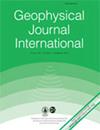求助PDF
{"title":"Direct assessment of the hydraulic structure of the plate boundary at the toe of the Nankai accretionary prism","authors":"Joshua Pwavodi, Mai-Linh Doan","doi":"10.1093/gji/ggad473","DOIUrl":null,"url":null,"abstract":"Summary The Nankai Trough is a locus of slow slip, low-frequency earthquakes, and large magnitude (Mw > 8) earthquakes. It is usually assumed that high pore pressure contributes substantially to earthquake dynamics. Hence, a thorough understanding of the hydraulic regime of the Nankai accretionary prism is needed to understand this diversity of behaviors. We focus on the toe of the accretionary prism by studying data from Hole C0024A, part of the Nankai Trough Seismogenic Zone Experiment (NanTroSEIZE) project, that intersected the décollement at 813 meters below seafloor (mbsf) about 3 km away from the trench. We contribute to this understanding by innovatively integrating drilling and logging data to derive high-resolution hydraulic profiles along the borehole. A quantitative re-analysis of the variation in the downhole annular pressure monitored during drilling show localized fluid flow from the formation to the borehole in excess of 0.05 m3/s, especially in the damage zones at the footwall of the décollement. To validate the fluid flow profile, pore pressure was estimated independently from empirical relationships between pore pressure, porosity, and P-wave velocity, obtained from consolidation experiments and Eaton-type methods based on drilling or sonic velocity data. The formation fluids are becoming significantly over-pressurized with depth in the few hundred meters above décollement. The hydraulic profile suggests that the core of the décollement acts as a barrier inhibiting upward fluid convection, whereas the damage zone acts as an efficient longitudinal channel able to diffuse high pressure from the deeper part of the subduction.","PeriodicalId":12519,"journal":{"name":"Geophysical Journal International","volume":"61 1","pages":""},"PeriodicalIF":2.8000,"publicationDate":"2023-12-09","publicationTypes":"Journal Article","fieldsOfStudy":null,"isOpenAccess":false,"openAccessPdf":"","citationCount":"0","resultStr":null,"platform":"Semanticscholar","paperid":null,"PeriodicalName":"Geophysical Journal International","FirstCategoryId":"89","ListUrlMain":"https://doi.org/10.1093/gji/ggad473","RegionNum":3,"RegionCategory":"地球科学","ArticlePicture":[],"TitleCN":null,"AbstractTextCN":null,"PMCID":null,"EPubDate":"","PubModel":"","JCR":"Q2","JCRName":"GEOCHEMISTRY & GEOPHYSICS","Score":null,"Total":0}
引用次数: 0
引用
批量引用
直接评估南开增生棱柱脚板块边界的水力结构
摘要 南海海槽是缓慢滑动、低频地震和大震级(Mw > 8)地震的发生地。通常认为,高孔隙压力对地震动力学有重大影响。因此,需要对南海增生棱岩的水力机制有透彻的了解,才能理解其行为的多样性。我们通过研究南海海槽成震带实验(NanTroSEIZE)项目的一部分--C0024A 号钻孔的数据,重点研究了增生棱岩的趾部,该钻孔在距海沟约 3 千米的海底以下 813 米(mbsf)处与增生棱岩相交。我们通过创新性地整合钻探和测井数据,沿钻孔推导出高分辨率的水力剖面,从而加深了对这一问题的理解。对钻井过程中监测到的井下环压变化进行的定量再分析表明,从地层流向井眼的局部流体流量超过 0.05 立方米/秒,尤其是在海沟底壁的破坏区。为了验证流体流动曲线,根据固结实验和基于钻井或声波速度数据的伊顿型方法得出的孔隙压力、孔隙度和 P 波速度之间的经验关系,独立估算了孔隙压力。在décollement以上几百米的深度,地层流体明显超压。水力剖面表明,dÃcollement的核心区是抑制流体向上对流的屏障,而破坏区则是能够扩散来自俯冲深部高压的有效纵向通道。
本文章由计算机程序翻译,如有差异,请以英文原文为准。


